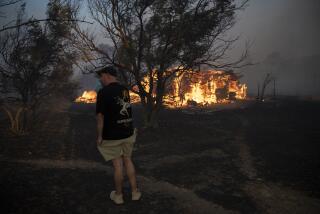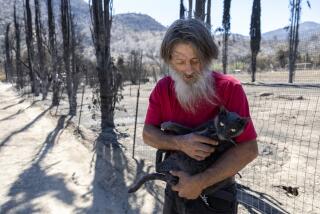From the Archives: From the ashes, new blooms rise
ALPINE, CALIF. -- When Keli and Dan Cadenhead came home from dinner that Saturday in October 2003, the sky north of their hilltop house was glowing orange. They watched all night as the light intensified, filled the horizon, finally reared its flaming head above a nearby ridge and roared, at 50 mph, toward their home in the backcountry east of San Diego.Keli fled to safety with their daughter. Dan stayed to hose the house some more, then raced to higher ground, where he watched flames roll over their 8 acres, engulfing all they owned. He told his family that the house was gone -- incinerated -- along with the acre of mostly native garden his wife had planted and nurtured for 18 years.For Keli, the garden was neither hobby nor vocation. It was an essential ritual, a daily commitment to the land and the plants she’d selected to line the steep drive up to their Southwestern-style house and to wrap around it.She’d even planted partway down the steep, chaparral-filled cliffs that form the mesa’s sides. Beavertail, pencil and barrel cactus, blue agaves, red yucca, palo verde trees, rockrose, lavender, lion’s tail. Cleveland sage, aloes, Geraldtown wax flower, fleabane, African ocotillo, lantana, Madagascar palm, sweet Alyssa. And hundreds more, the names of which she doesn’t know.”Out here, you don’t have to purchase succulents and cactus,” she says. “You trade with friends and neighbors. You don’t need a whole plant. Just break off a leaf of something like the beavertail, plant it and it will grow. Or you plant the pup that one cactus produces, and soon you have a whole new cactus.”Keli grew up near Alpine, in the foothills of the Cuyamaca Mountains.”I learned gardening as a child, from my mother, who knew all about succulents. It didn’t seem important to me then.” Later, plants became central. “I am a gardener,” she says, a badge of identity.While Dan worked his way up to president of a construction company, Keli gardened her way through raising two children. When they bought 8 acres in 1988 and built a home from scratch, she knew perfection would be achieved only after she’d planted and her garden was grown.”The garden is what made our house beautiful,” she says. “I didn’t exactly have a personal relationship with the plants, but working with them, having my hands in the dirt, is a kind of therapy. Each plant meant something special to me. Each had a story behind it, the story of who gave it to me and when.”In that context, each plant was irreplaceable. Simply planting a new one wouldn’t be the same.Two days after the blaze, dubbed the Cedar fire, had passed through, police barricades prevented residents from going back to the still dangerous area. Dan and Keli couldn’t wait. They outfitted his white Ford Expedition with a bar of flashing lights across the top so it would look like an official vehicle. The Cadenheads and some friends blew by two barricades with no trouble.”With our lights flashing, they didn’t think to stop us,” Dan says.”It was like driving on the moon. Everything around us was dead. Flat. Ashes. Telephone poles were still burning.”Trees, gardens and all the hardscape around their house has been demolished.”Like a bomb hit it,” he says. “Nothing left.”To their astonishment, the house was still standing. The fire, which eventually blackened 300,000 acres and destroyed 2,200 homes, had rolled over it. But an alarm was wailing from inside. Black smoke billowed as they opened the door, but they saw no flames. Dan found fire smoldering inside a dining room wall, which he knocked down while family and friends formed a bucket brigade from the pool. The fire was doused.”Insurance investigators later told us we’d saved our house,” Dan says. “If we’d gone back any later, we’d have lost it all.”There was nothing they could do to save the garden.--Loss of a garden to fire is traumatic. Yet long-term gardeners are an optimistic lot. They understand the regenerative powers of nature, the rewards of patience.Horticulturist Jo O’Connell, owner of an Australian native-plant nursery in Ventura, says it’s pointless to dwell on the downside of garden loss.”Of course, one’s very first thought is always, ‘Oh God, how horribly sad this is,’ ” O’Connell says. “Then you wait weeks or months and plants start regrowing and you think, ‘Oh God, how wonderful this is.’ “Not everything regenerates, she says. But plants native to California, Australia and South Africa have always endured fire and are somewhat equipped for it.”They have ways of responding, by flowering from the trunk, or coming back from the base, called the lignotuber,” she says. “The sumac, a common California native, is an example.”Others use different mechanisms for regrowth. Some have very hard seedcoats, she says.Fire breaks down the seedcoat and triggers germination, the rains arrive and the new plants come up.”The truth is once you go through all the agony of losing a garden to fire,” O’Connell says, “you can experience something very positive.”Evelyn Alemanni of Elfin Forest says she was devastated when she lost her 2-acre garden in the 1996 Harmony Grove fire in San Diego County.”I’m an obsessive gardener. I had worked nine years on that garden, at least 20 hours a week, doing everything myself,” she says. “I had a little greenhouse, did a lot of propagating, grew lots of plants from seeds. The fire took it all away.”But then it gave her a whole new life.”I got to start my garden over, correct my previous mistakes,” she says.Within four years the garden had grown to 3 acres and looked so good that she entered it in a 2001 “Good Morning America” contest for best garden in America. She was one of five finalists; both she and her garden were on TV. Viewers called and asked to visit, and Alemanni says she realized her garden wasn’t even the best in the neighborhood.So she founded the Elfin Forest Garden Festival tour in 2002. She entered the tour in the America in Bloom contest, and Elfin Forest won second place. Alemanni was invited to become a judge and has since traveled across the U.S., England, Scotland and Canada looking at her favorite things: gardens. Her life and her garden are better than ever, she says, “and it’s all a result of the fire.”--Keli CADENHEAD says she knew that many of the ravaged plants would eventually grow back, that nature would regenerate them. Yet she was distressed and despondent. When she looked at flattened, ash-strewn terrain, she wanted to help it, but couldn’t find the will to start.”The best way to describe what happened to her is to describe who she is,” says Dan, who married Keli 30 years ago. “This is a woman who wakes up at 5 or 6 every morning, walks outside and immediately starts tending her plants and animals, nurturing everything around her. That’s where she derives the most pleasure. After the fire, there was none of that. You could see it in her face. She wasn’t complete.”Dan got an idea to give her a jump-start. For years, they’d visited the annual Alpine Sage & Songbirds Garden Tour, gathering ideas, wondering if someday their own garden could be on the tour.”Dan saw how sad I was, knows what my garden meant to me,” Keli says. “He said, ‘Let’s set a goal. Let’s put the garden back together so it’s really beautiful, and get it on the tour for next year.’ “So she fertilized, watered, trimmed what was burned and scorched, and set about replanting about one-quarter of the garden, but with only native plants.”They’d shown me how hearty they are,” she says. “I had some in pots before the fire, waiting to plant. After the fire, they all looked dead. Within weeks they were growing again. They all survived. They’re used to heat, drought. And frankly, I think they’re more attractive. I see hibiscus, oleander or lawns with grass out here in the country, and they don’t look like they belong. They don’t belong. They are fighting Mother Nature. I’d rather join nature and grow what is meant to live here.”Keli accomplished her goal. About 80% of the plants came back successfully, she says. She replanted the other 20% and has added new ones.”One big joy of a garden is watching it constantly evolve,” she says.The garden was a highlight of the 2005 Sage & Songbird tour, but the fire saga isn’t over, the couple says. They still give thanks daily that out of 100 homes in the area, theirs was one of 20 that survived. The couple know the 2003 fire might not be their last.They’ve installed new irrigation lines down the north face of their hill, where the fire came from and might come again. As added protection, Dan will arm himself with a polymer spray gel that’s fire retardant. He’ll spray as much and as fast as he can, then he’ll [email protected] THE FIREA three-part series on Californians rebuilding their dreams.Last week: Artist James Hubbell loses his landmark home but not the will to re-create it.Today: It’s painful to see a house burn down, but watching a garden go up in flames can hurt just as much. What happens when a cherished landscape is destroyed -- and reborn.Next week: Laurie Frank embarks on a three-year odyssey to transform rubble back into home.






